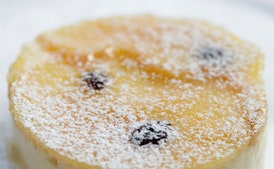
Introduction
Bread and Butter Pudding, a classic comfort dish with rich history, offers a delightful combination of soft bread, sweet raisins, and velvety custard. It’s perfect for cozy family gatherings or as an indulgent dessert.
Tips for this recipe
- Ensure butter is softened to the right consistency.
- Cut rolls uniformly for even cooking.
- Use golden raisins for their natural sweetness and chewy texture.
Why you will love this recipe
This pudding’s delectable taste profile is a blend of classic, indulgent flavors. The combination of soft bread with its rich custard base creates an irresistible dessert that satisfies your sweet tooth while reminiscing the charm of traditional baking.
Ingredients
- 5 tablespoons unsalted butter, softened
- 5 small, soft round rolls (about 10 ounces total), cut into 1-inch slices
- 1/2 cup golden raisins
- 3 1/3 cups whole milk
- 3 1/3 cups heavy cream
- 1/8 teaspoon fine sea salt
- 2 vanilla beans, split lengthwise
- 5 large eggs
- 1 1/4 cups sugar
Adviced equipments
For this recipe, the recommended equipment includes:
- Bread Loaf Pan/Pullman Pan
- Silicone Baking Mat
- Wooden Spoon
- Whisk
- Electric Mixer with Paddle Attachment (optional for larger batches)
- Heatproof Bowl (for double boiler usage)
- Digital Kitchen Scale
- Silicone Ice Cream Scoop
- Bread and Butter Pudding Ramekins (Set of 6)
History of the recipe
The Bread and Butter Pudding has roots tracing back to medieval European cuisine. It’s a practical dish, born from utilizing leftovers by combining stale bread with eggs and milk to create something new and satisfying. Over centuries, it evolved into the dessert we savor today, adapting regional variations that highlight local ingredients.
fun facts about this recipe
Did you know? Bread and Butter Pudding’s name comes from its use of stale bread. It represents a sustainable approach to cooking, transforming something near expiration into deliciousness. The dish has evolved significantly since medieval times but still holds the essence of ingenuity in every bite.



